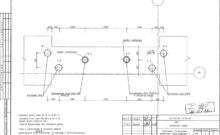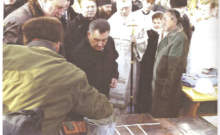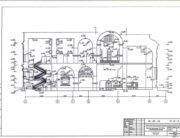In the act survey of the Church of St. John the Baptist from 1893, designate: “First, in the form of a square chamber, the altar was separated by three arches. On the southern side, the entire length of the church was the gap between the Forerunner and the Assumption church, 2 arshins 12 inches wide. From the southern part there was an ancient passage to the second floor. Now the course is immured, and the gap is used as a pantry. On the first floor of the vault box, lancet above the windows. On the second floor of the box, vaults over the apses are semi-recti. Above the middle and southern part of the hole for a through lamp on the four “axes” – sails, with a boiler vault based on 2 pillars and 2 walls. Under the lantern slate cornice. In the interval (from the south), a semi-arch with a longitudinal “sinus”. From this room there is an ancient exit to the choir above the “Meal” and to the roof. On the ground floor, in the diaconal floor (on the south side), the opening for the descent to the lower basement floor is currently closed. In the middle apse the door to the Stefanovsky chapel is pierced, in the southern wall there is a door to the pantry …
On the walls of the stucco no, kreschatye pillars smooth without eaves.
3 acts of one thousand eight hundred and ninety-three years with the participation of V. Nicholasv shows that the commission: “… examined the walls of the Church of St. John the Baptist in the choirs – this church was preserved in a completely ancient form … In the western, southern and northern walls there were windows and the corresponding depressions, laid with bricked-up wire … Passages made in the apses are deprived of arches or lintels, so the masonry falls out over them … The commission concluded that after repair and release from the institution and the windows and niches, you need to lay the aisles on the east side … top of the apses of the Forerunner Church, seen from the Preobrazhensky Chapel, ends with a semicircular vault. Above the middle aisle “three semicircular hollows in the form of windows” are visible.
As the historian K.Sherotsky wrote, “in the 17th century. this temple was divided into two floors, and its upper part was joined to the choirs of a large church. ”
“In the northwestern side-chapel, the entire old church of the Forerunner occupies one altar; there are 4 pillars in it (Not cruciform) and three apses, almost not participating from the thickness of the eastern wall; but they are separated by semi-columns, which can be seen from the side of the chapel of St. Archidam. Stephen; from the choir of the big church, the ancient door leads here; in the eastern wall in the upper parts of the apse are pierced the entrance to the chapel of the Transfiguration; below led stairs here, is now under the floor; windows are visible on the western and southern walls; in the sails – vocalists … “.
“St. John the Baptist Church and the lower basement level is slim below the site of the current level, and still remains unoccupied, and not plastered, since the time of the ancient device …”.
A brick altar, arranged in a special north predoltaria, part of it is contained in a semicircle of walls in the original place, with a height and width of 1 arsh. 4 ed. “.
“The Church of John the Baptist is all painted with a pictorial letter in the first half of the 19th century, with images relating to the life of St. John the Baptist.” In addition to the field studies of the monument, its archival research was also conducted. In 1982.1984-1986 and 1997-1998, detailed historical notes on the Assumption Cathedral were prepared, which were taken into account and used in the implementation of the latest, revised version of the project of rebuilding the church with the reconstruction of St. John the Baptist Church, proposed by M.V. Kholostenko.



















